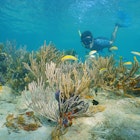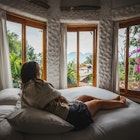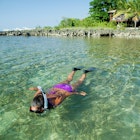

Thatched boathouse, Lake Yojoa, Honduras. Jpiks / Shutterstock
Spectacular Lago de Yojoa is the largest natural lake in Honduras and one of the fastest-growing traveler destinations in Central America’s least visited country. This biodiverse region delivers a refreshingly safe and tranquil respite for weary travelers looking to commune with nature in a remarkable setting.

Back in 2011, when Virginia native Bobby Durrette bought a struggling B&B in a small Honduran village miles from the beaten tourist path, it seemed unlikely that he would end up reshaping traveler patterns across Honduras in the process. But, arguably, that’s exactly what happened. In just a few years this sensational slice of Western Honduras has become an accompaniment – and sometimes even an alternative – to visiting tourism mainstays such as Copán or the Bay Islands.
If the severely potholed road between the bustling town of Peña Blanca and the sleepy village of Los Naranjos is anything to go by, this truly is the road less traveled: enormous cracks in the pavement cause even the fear-free drivers of Honduras to slow down, and after rains, miniature lakes form in the tarmac. Yet, despite this superficial evidence to the contrary, it seems that all backpackers head to Los Naranjos these days, home as it is to Durrette’s D&D Brewery, and within relatively easy reach of a slew of waterfalls, caves, plenty of excellent hiking and, of course, the stunning Lago de Yojoa.
The lake is truly a sight to behold: its 79 square kilometers of water lie in a depression formed by volcanoes, and it is surrounded by verdant mountain peaks covered in misty cloud forest. While the main highway between the Honduran capital Tegucigalpa and the second city of San Pedro Sula passes the lake’s eastern shore, no road leads to its western side, leaving it as a semi-wilderness teeming with rich bird and animal life.
What to do
A visit to Lago de Yojoa is all about embracing the natural world and taking in the lake’s raw beauty and mountainous surroundings. There are not many tour outfitters here, so nearly all visitors end up booking guides through D&D Brewery, but it’s also possible to do several excursions under your own steam. These include visiting the impressive Caves of Taulabé, where you can venture deep into the remarkable cave system full of delicate rock formations.
Independent travelers can also easily access the Los Naranjos Ecological and Archaeological Park, where several kilometers of trail connect with a kilometer-long boardwalk that stretches across the lake’s wetlands, giving visitors incredible access to all kinds of wildlife you won’t ordinarily have the chance to approach. The lake itself teems with bird life, best appreciated on a rowboat or kayak ride at dawn, and the nearby Pulhapanzak waterfall is only a 30 minute bus ride away; visit the cascade and climb behind the roaring water, zip-line in the surrounding forest, or just relax and take a dip in its cool waters.

You’ll need to hire guides for excursions that explore beyond the immediate vicinity of the lake, but their services are relatively affordable and can also be shared with other travelers. Destinations include two superb national parks, both of which offer some fantastic hiking opportunities. Parque Nacional Cerro Azul Meambar, to the east of the lake, contains miles of well-marked trails winding through the thick tropical forest, routes complete with waterfalls and caves. The smaller Parque Nacional Santa Bárbara, directly west of the lake, is home to Honduras’ second highest peak, Montaña de Santa Bárbara (2744m), which can be climbed with a local guide. One of the climb’s highlights is the opportunity to see one of the many quetzals that make the mountainside home – these spectacular creatures live at altitude, so you won’t see them anywhere down by the lake.
Where to stay
A model of progressive management with strong social and sustainable credentials, D&D Brewery offers both dorm and private accommodation, and is primarily oriented towards budget travelers; it’s the kind of place you’ll meet other backpackers and swap Central American travel stories over beers.
Should you be seeking solitude rather than communal spirit, other accommodation options are available around the lake. Finca El Paraiso is a gorgeous coffee plantation in Los Naranjos, where the genial owner has built various accommodations – including two superb tree houses – deep in the forest. Guests have free reign to explore nearby grounds, which include a rushing river, an azure pond and countless plants, trees and flowers.
Another good option is El Cortijo del Lago, the only property that fronts directly onto the lake itself. This place has recently been smartened up, and has simple but comfortable accommodation, including one free-standing cabin with lake views.
Where to eat
As you’d expect, fish feature heavily on local menus, and there’s nowhere better to try the catch of the day than Restaurante El Estoraque, a convivial and locally-famous fish restaurant on the lakeside. Here you’ll be served up huge plates of breaded, fried fish complete with tajadas (plantain chips), a selection of spicy dips and a variety of homemade encurtidos (pickled vegetables). D&D Brewery also has an excellent kitchen that serves up a tasty range of international dishes, including some superb chicken enchiladas and a much-loved house burger.
Make it happen
Reaching the area around Lago de Yojoa is easy. Direct hourly buses from San Pedro Sula pass through the village of Los Naranjos, and one daily bus runs from Tegucigalpa. Travelers coming from Copán or the Bay Islands will need arrive via San Pedro Sula.
This article was refreshed in August 2017.
Explore related stories




 BeachesThe 14 best places to visit in Central America: ruins, reefs and romantic beaches
BeachesThe 14 best places to visit in Central America: ruins, reefs and romantic beachesJul 30, 2024 • 8 min read






